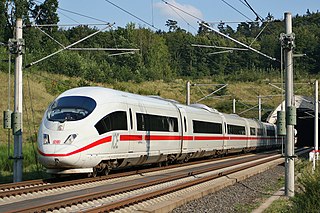
A multiple-unit train or simply multiple unit (MU) is a self-propelled train composed of one or more carriages joined together, which when coupled to another multiple unit can be controlled by a single driver, with multiple-unit train control.

Exo, officially known as Réseau de transport métropolitain, is a public transport system in Greater Montreal, including the Island of Montreal, Laval, and communities along both the North Shore of the Mille Îles River and the South Shore of the St. Lawrence River. It was created on June 1, 2017, taking over from the Agence métropolitaine de transport. The RTM operates Montreal's commuter rail and metropolitan bus services, and is the second busiest such system in Canada after Toronto's GO Transit. In May 2018, the erstwhile Réseau de transport métropolitain (RTM) rechristened itself as Exo.
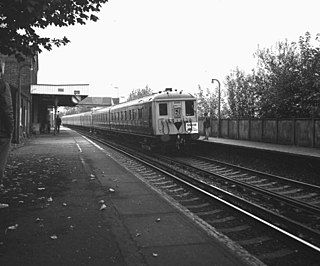
The Southern Railway (SR) gave the designation 2-BIL to the DC third rail electric multiple units built during the 1930s to work long-distance semi-fast services on the newly electrified lines from London to Eastbourne, Portsmouth and Reading. This type of unit survived long enough in British Rail ownership to be allocated TOPS Class 401.

The Southern Railway (SR) gave the designation 4-LAV to the electric multiple units built to work the semi-fast services on the route between London and Brighton. None of these units survived long enough in British Rail ownership to be allocated a TOPS class.
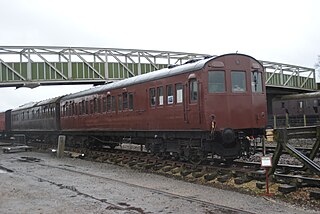
The T Stock was a series of electric trains originally built in various batches by Metropolitan-Vickers and the Birmingham Railway Carriage and Wagon Company for the Metropolitan Railway in 1927–31 for use on electric services from Baker Street and the City to Watford and Rickmansworth, though rarely some worked on the Uxbridge branch.

Canadian Car and Foundry (CC&F), also variously known as "Canadian Car & Foundry" or more familiarly as "Can Car", was a manufacturer of buses, railway rolling stock, forestry equipment, and later aircraft for the Canadian market. CC&F history goes back to 1897, but the main company was established in 1909 from an amalgamation of several companies and later became part of Hawker Siddeley Canada through the purchase by A.V. Roe Canada in 1957. Today the remaining factories are part of Bombardier Transportation Canada.
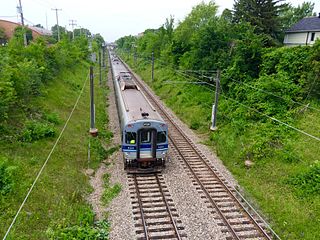
Deux-Montagnes or Two Mountains Line was formerly a commuter railway line in Greater Montreal, Quebec, Canada. It was owned by Exo, the organization that operates public transport services across this region.
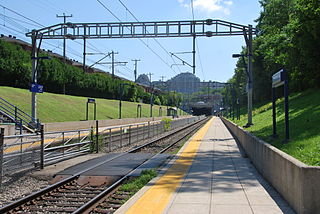
The Mount Royal Tunnel is a railway tunnel in Montreal, Quebec, Canada. The tunnel is the third longest in Canada, after the Mount Macdonald Tunnel and the Connaught Tunnel, and connects the city's Central Station, in Downtown Montreal, with the north side of Montreal Island and Laval and passes through Mount Royal.

EN57 is an electric multiple unit used by the Polish railway operator (PKP). It was built for suburban and long-distance services. Presently it is used by Przewozy Regionalne (POLREGIO), Szybka Kolej Miejska and Koleje Mazowieckie companies. Out of over 1400 units produced, about 300 still remain in service in Poland, most of them with Przewozy Regionalne.

The British Rail Class 502 was a type of electric multiple-unit passenger train, originally built by the London Midland and Scottish Railway at its Derby Works. Introduced in 1940 and withdrawn by 1980, they spent the whole of their working lives on the electrified railway lines north of Liverpool.

The British Rail Class 506 was a 3 carriage Electric Multiple Unit (EMU) built for local services between Manchester, Glossop and Hadfield on the Woodhead Line, which was electrified in 1954 on the 1,500 V DC overhead system.

The Tait trains were a wooden bodied Electric Multiple Unit train that operated on the suburban railway network of Melbourne, Victoria, Australia. They were introduced in 1910 by the Victorian Railways as steam locomotive hauled cars, and converted to electric traction from 1919 when the Melbourne electrification project was underway. The trains derived their name from Sir Thomas James Tait, the chairman of commissioners of the Victorian Railways from 1903 to 1910. The first cars were built during 1909 with the last entering service in 1952.

The MR-90 is a class of single-level electric multiple unit (EMU) railcars built in 1994-1995 by Bombardier Transportation for the Société de Transport de la Communauté Urbaine de Montreal (STCUM) and now operated by Exo. These cars were ordered when the Deux-Montagnes line was completely rebuilt from 1993 to 1995 and all the equipment and infrastructure was replaced.

The Erie Lackawanna MU Cars were a fleet of electric multiple unit commuter railcars used by the Delaware, Lackawanna and Western Railroad (D&LW) and successor railroads in the state of New Jersey. The D&LW undertook electrification of its Morristown Line and related branches in 1929–1930, and purchased 141 motor cars from Pullman to operate it. These were supplemented by 141 unpowered trailers of various types which were converted from existing rolling stock. The multiple units were successful and remained in service until 1984.
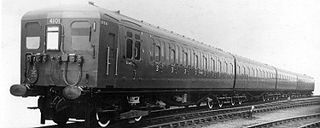
The Southern Railway (SR) and the British Railways used the designation Sub to cover a wide variety of electric multiple units that were used on inner-suburban workings in the South London area. The designation ‘Sub’ was first officially used in 1941 to refer to newly built 4-car units. However, during the 1940s large numbers of earlier ‘3-Car Suburban Sets’ were increased to four cars by the addition of an 'Augmentation' trailer, and became part of the 4-Sub category. The SR and BR (S) continued to build or else rebuild 4-car units to slightly different designs which became part of the 4-Sub Class. Many of these later examples survived in passenger use until late 1983, by which time British Rail had allocated to them TOPS Class 405.

The CN Boxcab Electrics were a series of six electric locomotives built by General Electric for the Canadian Northern Railway in 1917. They were used in service through the Mount Royal Tunnel in Montreal until retirement in 1995, operating for 76 years, 7 months and 12 days.

The New South Wales Standard suburban carriage stock are a class of electric multiple units that were operated by the New South Wales Government Railways and its successors between 1926 and 1992. They served on the Sydney suburban network. In the years before their withdrawal, they were nicknamed Red Rattlers.

The New South Wales Tulloch suburban carriage stock were a type of electric multiple unit operated by the New South Wales Government Railways and its successors between 1940 and 1992. In their later years, they were nicknamed Red Rattlers.

The New South Wales Bradfield suburban carriage stock were a type of electric multiple unit operated by the New South Wales Government Railways and its successors between 1921 and 1975.

The Keihan 9000 series is an electric multiple unit (EMU) commuter train type operated by the private railway operator Keihan Electric Railway in Kyoto, Japan, since 1997.




















